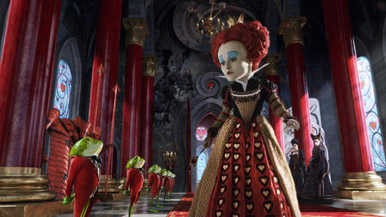Book vs. Movie:
Alice in Wonderland
By Russ Bickerstaff
March 10, 2010
In this corner: the Book. A collection of words that represent ideas when filtered through the lexical systems in a human brain. From clay tablets to bound collections of wood pulp to units of stored data, the book has been around in one format or another for some 3,800 years.
And in this corner: the Movie. A 112-year-old kid born in France to a guy named Lumiere and raised primarily in Hollywood by his uncle Charlie "the Tramp" Chaplin. This young upstart has quickly made a huge impact on society, rapidly becoming the most financially lucrative form of storytelling in the modern world.
Both square off in the ring again as Box Office Prophets presents another round of Book vs. Movie.
Alice In Wonderland
At some point in the mid-19th century, Reverend Charles Lutwidge Dodgson took a journey up the River Thames with three girls, ranging in ages from eight to 13. In an effort to entertain the girls on the journey, Dodgson told them a rather nonlinear story about a little girl named Alice who went in search of adventure. The girls loved the story, particularly the ten-year-old, who was herself named Alice. Legend has it that Alice asked Dodgson to write down the story. A couple of years later, he got around to doing so, adding bits to it to turn it into a more slightly more substantial story, as Dodgson was looking to have it published. Nearly three years after the river journey happened, the story was published as Alice's Adventures In Wonderland under the pen name of Lewis Carroll. The book was successful enough that "Carroll" wrote a sequel to the book some time later - Alice's Adventures Through The Looking Glass. The pair of books became hugely popular. Over the years, the two books have been developed into a number of stage and film adaptations. Aspects of the story have entered pop culture in a very big way. Early in 2007, producer Joe Roth was developing a live-action adaptation of the film. Later on that year, Tim Burton signed on to the project, bringing one of the biggest names in offbeat contemporary fantasy movies to the latest adaptation of Dodgson's classic. How does the latest incarnation of the story compare with the original book?
The Book
The original book is light, breezy and profoundly surreal. The story opens with the young title character chasing a white rabbit in a waistcoat down a rabbit hole. From there, it gets a little weird. What follows doesn't have a traditional plot arc. Alice's adventures are feverishly pieced together with strange dream logic and plenty of fantastically vivid wordplay. Eventually, she returns to the real world. The sequel finds her traveling to an entirely different place as she steps through a mirror. When she finishes her journey, Alice has been through a great deal. There is a sense that she's grown-up quite a bit through her journeys.
Bits of the story are remarkably familiar. What's often overlooked is just how dark the original books are. The amazing thing is how much Carroll balanced the darkness against mad, whimsical humor. There's a subtlety to the books that likely make them a lot more enjoyable to adults of a certain bent than they would be for most modern children. Nearly everyone is familiar with Alice's fall down the rabbit hole and subsequent difficulty with trying to find the perfect size. Between a cake and a potion, her size rapidly changes. When she starts crying, things get a bit fuzzy.
Continued:
1
2
3

![]() Tweet
Tweet
![]() Print this column
Print this column



